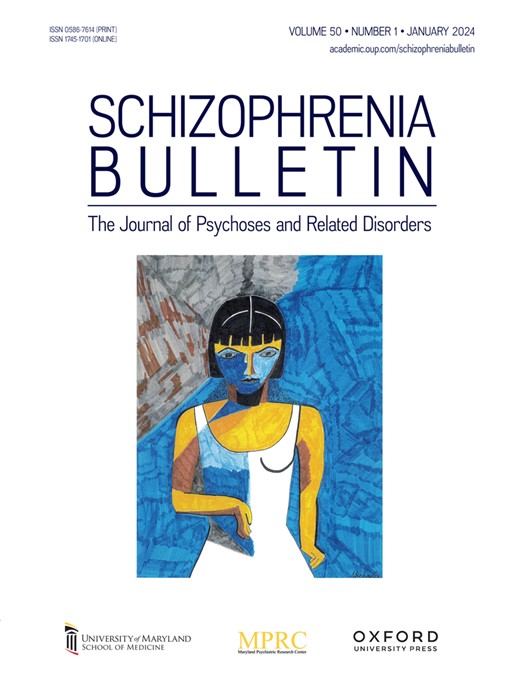IF 5.3
1区 医学
Q1 PSYCHIATRY
引用次数: 0
摘要
背景与假设 许多精神障碍患者都表现出时间折扣(TD)增加,即他们对未来回报的折扣比健康对照组更高。然而,精神分裂症和被认为属于精神分裂症谱系的人格分裂型的研究结果却不太清楚。此外,在精神分裂症谱系中,未来时间表征在TD中的作用尚未得到研究。我们假设,当未来奖励的时间点以日期而非延迟单位表示时,精神分裂症人格特质与TD之间存在正相关,而当未来奖励的时间点以日期而非延迟单位表示时,精神分裂症人格特质与TD之间存在负相关(日期/延迟效应)。此外,我们还探讨了精神分裂症与日期/延迟效应大小之间的关联。研究设计 我们进行了一项大规模的普通人群在线研究(N = 1000),用货币选择问卷(MCQ)评估TD,用牛津-利物浦感觉和体验短量表(sO-LIFE)评估精神分裂症特质。MCQ中的时间表征(日期与延迟)在受试者内部进行了调整。研究结果 经 Bonferroni 校正后,TD 与 sO-LIFE 子量表之间的关联不显著(所有 r 均小于 0.06)。日期/延迟效应被成功复制(P < .001, gav = 0.22)。有趣的是,在控制了其他 sO-LIFE 子量表、年龄、教育程度和吸毒的影响后,sO-LIFE 异常经历子量表的较高值预测了日期/延迟效应的大小。结论 TD 与精神分裂症无关,但精神分裂症阳性程度较高的个体对未来时间点的表征操作更为敏感。未来的研究应重点关注这些过程,因为它们是精神分裂症谱系中认知知觉缺陷的发展和治疗的潜在机制。本文章由计算机程序翻译,如有差异,请以英文原文为准。
The Relationship Between Schizotypal Personality Traits and Temporal Discounting: The Role of the Date/Delay Effect
Background and Hypothesis Many patients with psychiatric disorders show increased temporal discounting (TD), ie, they discount future rewards more steeply than healthy controls. However, findings for schizophrenia and schizotypy, a personality constellation considered to be on the schizophrenia spectcrum, are less clear. Moreover, the role of future time representation in TD in the schizophrenia spectrum has not been examined. We hypothesized positive associations between schizotypal personality traits and TD and reduced TD when the timepoint of future rewards is represented in dates rather than delay units (the date/delay effect). Further, we explored associations between schizotypy and the magnitude of the date/delay effect. Study Design We conducted a large-scale, general-population online study (N = 1000) assessing TD with the Monetary Choice Questionnaire (MCQ) and schizotypal traits with the Short Oxford-Liverpool Inventory of Feelings and Experiences (sO-LIFE). Time representation in the MCQ (dates vs delays) was manipulated within subject. Study Results Associations between TD and sO-LIFE subscales were not significant after Bonferroni correction (all r ≤ .06). The date/delay effect was successfully replicated (P < .001, gav = 0.22). Interestingly, higher values in the sO-LIFE Unusual Experiences subscale predicted the magnitude of the date/delay effect when controlling for influences of other sO-LIFE subscales, age, education, and drug use. Conclusions TD was not associated with schizotypy, but individuals with higher levels of positive schizotypy were more sensitive to manipulations of the representation of future timepoints. Future studies should focus on these processes as potential mechanisms in the development and treatment of cognitive-perceptual deficits in the schizophrenia spectrum.
求助全文
通过发布文献求助,成功后即可免费获取论文全文。
去求助
来源期刊

Schizophrenia Bulletin
医学-精神病学
CiteScore
11.40
自引率
6.10%
发文量
163
审稿时长
4-8 weeks
期刊介绍:
Schizophrenia Bulletin seeks to review recent developments and empirically based hypotheses regarding the etiology and treatment of schizophrenia. We view the field as broad and deep, and will publish new knowledge ranging from the molecular basis to social and cultural factors. We will give new emphasis to translational reports which simultaneously highlight basic neurobiological mechanisms and clinical manifestations. Some of the Bulletin content is invited as special features or manuscripts organized as a theme by special guest editors. Most pages of the Bulletin are devoted to unsolicited manuscripts of high quality that report original data or where we can provide a special venue for a major study or workshop report. Supplement issues are sometimes provided for manuscripts reporting from a recent conference.
 求助内容:
求助内容: 应助结果提醒方式:
应助结果提醒方式:


